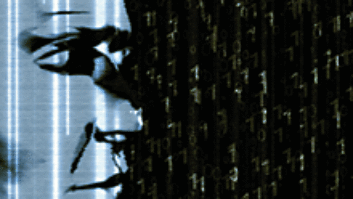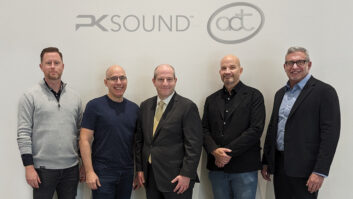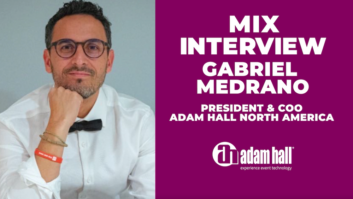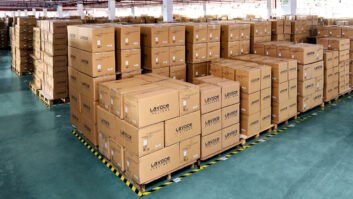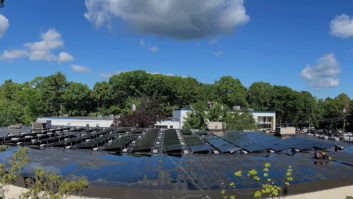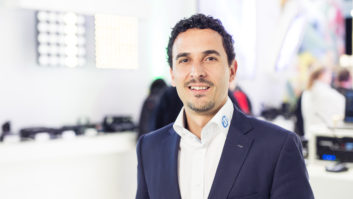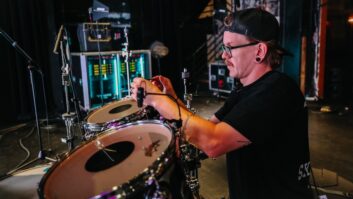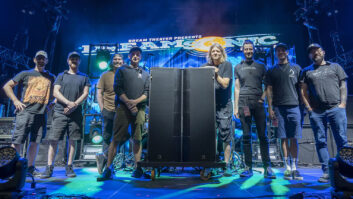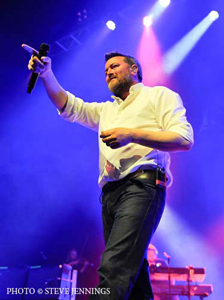
Elbow lead vocalist Guy Garvey at The Fox Theater in Oakland, Calif.
Photo: Steve Jennnings
UK pop-rock band Elbow—Guy Garvey (vocals), Mark Potter (guitar), Pete Turner (bass), Craig Potter (keyboards) and Richard Jupp (drums)—played 12 dates in North American clubs in spring 2014, sandwiched in between arena concerts in the UK (including London’s O2 Arena) and festivals in Russia and Europe.
The band embarked on their first U.S. tour since 2011 to promote their 2014 release, The Take Off and Landing of Everything, the band’s sixth. Mix saw their appearance at The Fox Theater in Oakland, Calif., in late May.
Elbow presented a dynamic, texture-oriented set emphasizing Garvey’s vocals and, alternately, guitar and synths, with two keyboard rigs onstage. “There is quite a lot of variety in the material, and some of the songs from the new album feature keys and synths more prominently,” says FOH engineer Danny Evans. “Pete Turner plays synths and samplers on several songs in order to re-create sounds from the album recordings.

Front-of-house engineer Danny Evans
Photo: Steve Jennings
“We didn’t carry any audio production on the U.S. tour as we were quite restricted on budget,” he adds. “We just took our mic box and some IEM systems, which Shure very helpfully loaned to us. We locally hired the FOH and monitor desks at each gig.” The tour also depended upon house P.A. systems; at The Fox Theater, they had a Meyer Sound rig. “There are a lot of good systems out there these days, though,” Evans adds. “For example, the L-Acoustics line arrays are great, too. My preference at the moment is the d&b [audiotechnik] J-Series, which we hire from Skan for all UK gigs and European gigs, wherever possible. It’s very smooth and detailed sounding, there is always headroom to spare, and it gives very even coverage.”
Evans mixed on the Fox’s Avid D-Show. “For me, the Avid Profile is intuitive and quick to get around,” he says. “I certainly like the ability to use the third-party plug-ins I use in the studio. We were using a wireless Shure KSM9 for Guy’s vocal. It goes straight into the desk and then through a Waves Renaissance Compressor, a McDSP DE555 de-esser and a Waves C6 multiband compressor. I use Waves reverbs on his vocal and various delays and ADT effects, depending on the song. On the output group for his vocal I have additional EQ—Waves Q10 and Renaissance EQ—to correct the tonality of his voice through the P.A. and to compensate for the acoustics of the room on the day—but I don’t use any additional outboard inserts or effects these days.”

Monitor engineer Julien Helme
Photo: Steve Jennings
Monitor engineer Julien Helme says that for this tour, Garvey and Mark Potter are on Shure PSM1000 stereo RF IEMs, Jupp and Craig Potter on Shure PSM600 hardwire stereo IEMs, and Turner with a mono wedge mix. “There was also a mono thumper feed for the drummer, who was using a Porter & Davies BC2. We had two string players on mono hardwire packs, also. For me, the less RF onstage the better, so if any musicians are static, I prefer to put them on hardwire packs.
“Along with the band’s two RF IEM systems I run a complete spare system fed off of a matrix mixer, so this gives me a complete set of redundant transmitter, receiver and cable feeding it in case any of the others go down.” Helme continues. “The default mix going to this spare matrix is the singer’s, but the other mixes are dialed in and ready to be turned on, if need be. I have a cue RF system and two tech systems as well. The tech systems are fed with the guitarist’s mix for our guitar tech and the drum mix for the drum tech. As I run these off matrixes as well I can feed my [talkback] mic, FOH [talkback] mic and the two tech-shout mics we have, [stage-right] and [stage-left], to these for complete communication between us all independently of the band.

Elbow at The Fox Theater in Oakland, Calif., in late May 2014
Photo: Steve Jennings
“Due to the flexibility of the matrix mixing I can blend the cue signal in with these switched crew-shout mics as well, so if anyone talks on their mic it comes straight to my ears no matter what I am doing.
“I use snapshots for every song to give the flexibility of tweaks,” Helme adds, “mainly just channel mutes and aux sends to try and keep it simple but are are a few dynamics recalls, as well.”
Helme mixes monitors on an Avid SC48. “I normally use an Avid Profile, but as we were hiring and due to budget and availability constraints, I had to adapt the show onto the SC48,” he says. “I can fit it on there provided it is fitted with the optional 8x XLR output card; on this tour I was using 22 analog outputs and the SC48 only has 16 as standard. It gives you the same functionality as the Profile but I like its size and the fact its all self-contained—no separate stage boxes [are needed], and such. The SC48 is a bit limited on DSP for plug-ins, but as my show file is relatively simple compared to, say, an involved FOH file, then there was just enough DSP to cover it.
Helme makes use of the SC48’s onboard plug-ins for the band’s vocals: “I use a Waves C6 multiband compressor on the main vocal and a mixture of Reverb One and ReVibe reverbs for the rest. As I only have one wedge mix and to save on DSP for the SC48, I disabled the onboard graphics and just use a parametric EQ for this mix. I actually prefer this, as you can be more precise with your EQ than with a standard graphic [EQ].”
